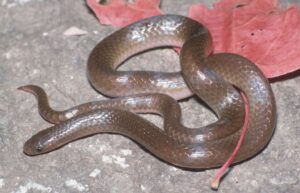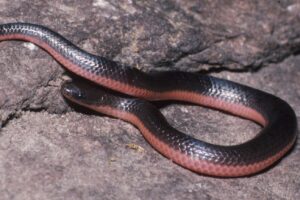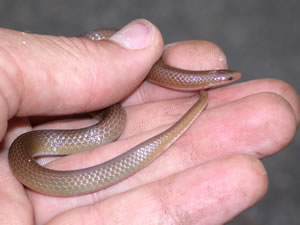Worm snakes are nonvenomous species native to the eastern part of the United States. They replicate worms, earthworms in particular, which is also one of their primary food sources, thus resulting in its name.
Scientific Classifications
- Suborder:Serpentes
- Family:Colubridae
- Genus:Carphophis
- Species:C. amoenus
Conservation Status
Subspecies
The worm snake has two recognized subspecies:
- Eastern Worm Snake (Carphophis amoenus amoenus)
- Midwestern Worm Snake (Carphophis amoenus helenae)
Description
Size
These small snakes have a length of around 8-11 inches, with a maximum size recorded at 13 inches.
Color and Appearance
These snakes appear brown on the dorsal side and bright pink on the ventral portion. Their belly has a brighter coloration, a part of which also extends up to their body. They have smooth dorsal scales arranged in rows of 13. Another highlighting feature is their tail, appearing shorter than their body and ends in a spine-like scaly projection. These snakes exhibit sexual dimorphism, with females being longer with shorter tails. Other significant physical features include their pointed, conical-shaped head and small eyes.
The juvenile worm snakes have similar coloration as their adult counterparts.
Are they Dangerous to Humans
Being nonvenomous, the worm snakes aren’t dangerous. However, if picked up, they would emit a foul-smelling liquid as a defense mechanism.
Worm Snake at a Glance
Distribution
These snakes occupy most parts of the Eastern United States. Their range includes the east of Mississippi, southwest Mississippi, southern Alabama, west to Louisiana, and north to Illinois.
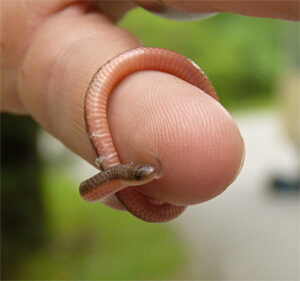
Habitat
Their common habitat includes woodlands and grasslands, mainly inhabiting rotten logs, leaf litter, and stumps. They are abundant within their range, yet these snakes are rare due to their lifestyle and where they live. They mostly prefer moist soils, particularly those inhabited by earthworms. One could spot them more frequently after heavy rainfall.
Lifespan
They have a moderately short lifespan, living for less than four years.
Predator
Their predators include thrushes, American robins, opossums, barn owls, and other snake species.
Diet
Their diet mainly comprises earthworms, but they may feed on insect larvae and other soft-bodied invertebrates.
Reproduction
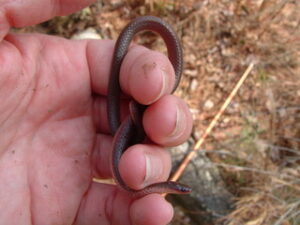
Mating and courtship mostly start in spring, with April – June being the active months when both sexes are spotted together. Between May and June, the eggs can be observed in the female’s translucent venter (abdomen). The egg-laying period spans between late June, and early July, laid in clutches of 2-8 under rocks, stumps, and rotting wood. The eggs appear long and smooth, around 1 inch long and 0.40 inches wide. One egg may often look wider than the other.
Pet Care Sheet
Housing
A 10-gallon terrarium would be an ideal enclosure choice.
Temperature
The preferred temperature should be 70 – 80 º F during the day and around 67 º F at night.
Humidity
The humidity level of their habitat must be around 60 to 70%.
Substrate
The substrates for their dwelling may include peat, moss, forest bedding, and coco husk.
Diet
Earthworms, slugs, caterpillars, waxworms, butterworms, and snails are among the food that one could offer them in captivity.
Source
herpsofnc.org, herpsofnc.org, natureblog.org, discoverlife.org, srelherp.uga.edu

